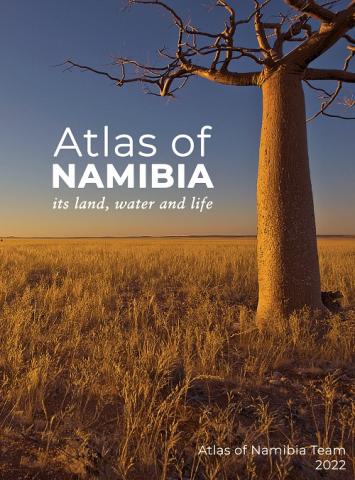
Atlas of Namibia - its land, water and life
Namibia comprises about 824,000 square kilometres and stretches 1,570 kilometres along the shores of the Atlantic Ocean from the Orange River in the south to the Kunene River in the north, straddling the Tropic of Capricorn. It is this position in southwestern Africa - where dry, high-pressure anticyclones influence the weather for much of the year, and the cold Benguela Current pushes northwards along the coast - that determines Namibia's overriding aridity. Surface water is scarce, except along the country's northern and southern borders. Namibia's dry climate is characterised by rains that fall for only a short period each year and high evaporation rates. As a result, soils are shallow and poorly developed, vegetation cover is sparse and much of the land can support only low densities of wildlife, livestock and people. Although the Benguela offers only a small contribution of water in the form of fog, it liberally provides nutrients that support a rich and productive marine environment and drives the sands of the Namib and diamonds from the Orange River onshore, all of which contribute importantly to Namibia's economy. The land that makes up Namibia has been arid for millions of years, but it was not always so. The country has a very much longer geological history that has seen it pushed and pulled and moved along - together and within supercontinents - across large areas of the southern hemisphere, through ice and heat, moisture and dryness. Evidence of this can be seen in the rocks and landforms that define Namibia today. These ancient land forms, together with the more recent windblown sands and sparse vegetation cover have shaped the country into many distinct landscapes. Much more recently, humans have further moulded Namibia's landscape through the activities they pursued to make a living and by defining the country's borders. These and other important features and processes define the character of Namibia as it is today and are described in this atlas.
| Attachment | Size |
|---|---|
| PDF of Prelim pages: Foreword, Atlas of Namibia Team, acknowledgements, preface, abbreviations, metric prefixes | 5.25 MB |
| PDF of Chapter 1: Introduction | 13.44 MB |
| PDF of Chapter 2: Landforms and Geology | 72.22 MB |
| PDF of Chapter 3: Climate | 29.6 MB |
| PDF of Chapter4: Water | 58.5 MB |
| PDF of Chapter 5: Soil | 50.66 MB |
| PDF of Chapter 6: Vegetation | 54.56 MB |
| PDF of Chapter 7: Wildlife | 49.41 MB |
| PDF of Chapter 8: Land | 69.72 MB |
| PDF of Chapter 9: Namibia's People | 51.97 MB |
| PDF of Chapter 10: Namibia in Detail | 90.07 MB |
| PDF of Chapter 11: Namibia in Detail | 77.37 MB |
| PDF of End pages: Glossary, notes and references, image credits, index | 6.19 MB |